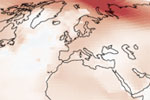Climate and The Oceans by Dr. Geoffrey K. Vallis provides a coherent, well-articulated primer on how the oceans impact the Earth’s climate. This easy-to-read illustrated
book, filled with both data and accessible mathematical equations demonstrating the impact of the oceans on the Earth’s climate, offers practitioners
and stakeholders’ state-of-the-art scientific analysis of how the oceans and climate interact that is both user friendly to the non-expert yet
scientifically rigorous enough as bridge material for graduate students as they grapple with the compelling field of climate science and oceanography.
Climate and The Oceans
provides an overview of the interaction between the oceans and the climate. It then follows this with chapters on circulation, seasonality, latitudinal
and longitudinal heat transport from the oceans’ floor to its surface, climate variability, and global warming. It is also includes a succinct glossary
along with chapter notes and suggested readings organized by topics.
Dr. Vallis writes an effectively organized and cogent analysis of two particular issues that stand out. These two issues are probability and
timescales. Probability means the possibility that an outcome will occur given a set of variables. Timescales means if this outcome does occur, over
what timescale this outcome might occur.
For example, while it is known that climate change and the Earth’s oceans have specific feedback loops with possibly catastrophic outcomes – think of
the melting of the great ice sheets of Greenland and West Antarctica and this impact on sea level rise, acidification, the thermohaline, North Atlantic
gyre circulation rates, and others – it is not necessarily clear what the probability of these impacts will be over which timescales.
Because many calculations of the carbon cycle demonstrate that even after greenhouse gases including carbon dioxide emissions cease, the levels of
greenhouse gases in the atmosphere will not diminish because greenhouse gases have significant long-term half-lives in the atmosphere. This suggests
that while scientists today may not know what the exact probability is on a short-term timescale, such as ten-years, that, for example, the great ice
sheets of Greenland and West Antarctica will melt within this short-term timeframe, these ice sheets over the long-term, such as 100-years, will have a
significantly increased probability of melting. This would result in possible 5°C (and even 10°C) increases in our Earth’s current temperature
resulting in unparalleled catastrophic impacts on the Earth’s oceans and life on Earth that scientists currently can only model partially.
Climate and The Oceans
is part of Princeton Primers in Climate, a series of precise and state-of-the-art
authoritative books that explain the current state of climate science research. These authoritative, short books are written specifically for
stakeholders, students, researchers, and scientifically oriented general readers needing precise, easy-to-read resources on
global climate change and climate science. These books at Princeton Primers in Climate are a superb resource to find meticulous, detailed, and
clearly presented facts on climate change science.
How to order:
Climate and The Oceans
Paperback: 231 Pages
Publisher: Princeton University Press
ISBN: 9780691150284
Authors: Dr. Geoffrey K. Vallis
Gabriel Thoumi, CFA is a frequent contributor to Mongabay.com.
Related articles
The Cryosphere-Princeton primers in climate: A Book Review
(01/23/2012) The Cryosphere by Dr. Shawn J. Marshall, Canada Research Chair in Climate Change, University of Calgary, is an excellent book because it summarizes leading scientific
research into easily accessible chapters each one on a different component of the cryosphere. The cryosphere, which incorporates the Earth’s snow and
ice mass including seasonal snow, permafrost (both land-based permafrost and below water permafrost), river and lake ice, sea ice, glaciers, ice
sheets, and ice shelves, is intrinsically related to global climate change. Hence, understanding how the cryosphere interacts with and is at risk
because of climate change and its greenhouse gases is fundamental to developing effective policy mechanisms that mitigate climate change.
NASA: 2011 ninth warmest year yet

(01/23/2012) Despite being a strong La Niña year, which tends to be cooler than the average year, 2011 was the ninth warmest year on record and the warmest La Niña yet, according to a global temperature analysis by NASA. To date, nine of the world’s ten warmest years have occurred since 2000 according to data going back to 1880.
Deforestation, climate change threaten the ecological resilience of the Amazon rainforest
(01/19/2012) The combination of deforestation, forest degradation, and the effects of climate change are weakening the resilience of the Amazon rainforest ecosystem, potentially leading to loss of carbon storage and changes in rainfall patterns and river discharge, finds a comprehensive review published in the journal Nature.